
Last Updated on October 30, 2025 by David
Revitalize Your Faded Victorian Mosaic Tiles with Proven Restoration Techniques
- Victorian mosaic tiles often lose their vibrancy due to ingrained dirt, old coatings, and surface wear, all of which can be exacerbated by environmental factors. A thorough assessment is crucial to determine the depth of fading and to develop a tailored restoration strategy.
- Harsh chemicals and aggressive scrubbing can irreversibly strip original pigments from the tiles, especially on encaustic and geometric varieties, causing lasting damage. Selecting the appropriate cleaning method is vital to ensure the preservation of tile integrity and beauty.
- Safe restoration starts with an in-depth cleaning process using pH-neutral solutions alongside low-speed rotary machines fitted with soft brushes. This gentle yet effective technique prevents damage while thoroughly cleaning the tiles.
- To effectively assess the true condition of the tile surface, old sealers and waxes need to be carefully removed. This crucial step sets the stage for successful restoration and allows for the identification of necessary interventions.
- Achieving colour enhancement involves utilizing breathable, stone-safe sealers that enhance the tile tones without creating an unsightly glossy film. It is essential to choose products specifically formulated for this purpose to maintain aesthetic appeal.
- Professional restoration methods can rejuvenate original pigments without resorting to repainting or artificial dyes, thus maintaining the authenticity of the tiles. Relying on skilled experts in the field is vital for achieving the best results.
- To ensure the longevity of restored tiles, it is important to implement gentle cleaning routines and steer clear of acidic or bleach-based products, which can adversely affect the restored finish. Educating oneself on proper care techniques is essential.
- Utilizing heritage-sensitive methods is key to preserving both the visual beauty and historical significance of these exquisite tiles. A deep understanding of their historical context can greatly enhance the restoration process.
Explore Effective Strategies for Restoring Victorian Tiles
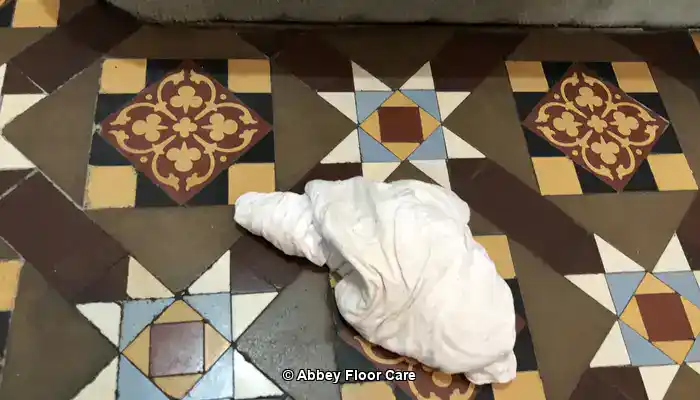
Abbey Floor Care restoring the colour to a Victorian clay tile floor using a colour-enhancing impregnating sealer.
Victorian encaustic and mosaic tiles are integral to the rich tapestry of British architectural heritage. They are celebrated for their intricate craftsmanship and distinctive colour palettes, created from mineral pigments that are fused directly into the clay tile bodies. These tiles not only fulfill an aesthetic function but also encapsulate the historical narrative of the period in which they were crafted, making their restoration essential for safeguarding cultural integrity. The restoration process ensures that the vibrant history and artistry of these stunning tiles are passed down to future generations, reinforcing their cultural significance.
Pro Tip: Recommended Products for Daily Maintenance of Victorian Tiles

Fila Pro Floor Cleaner
|
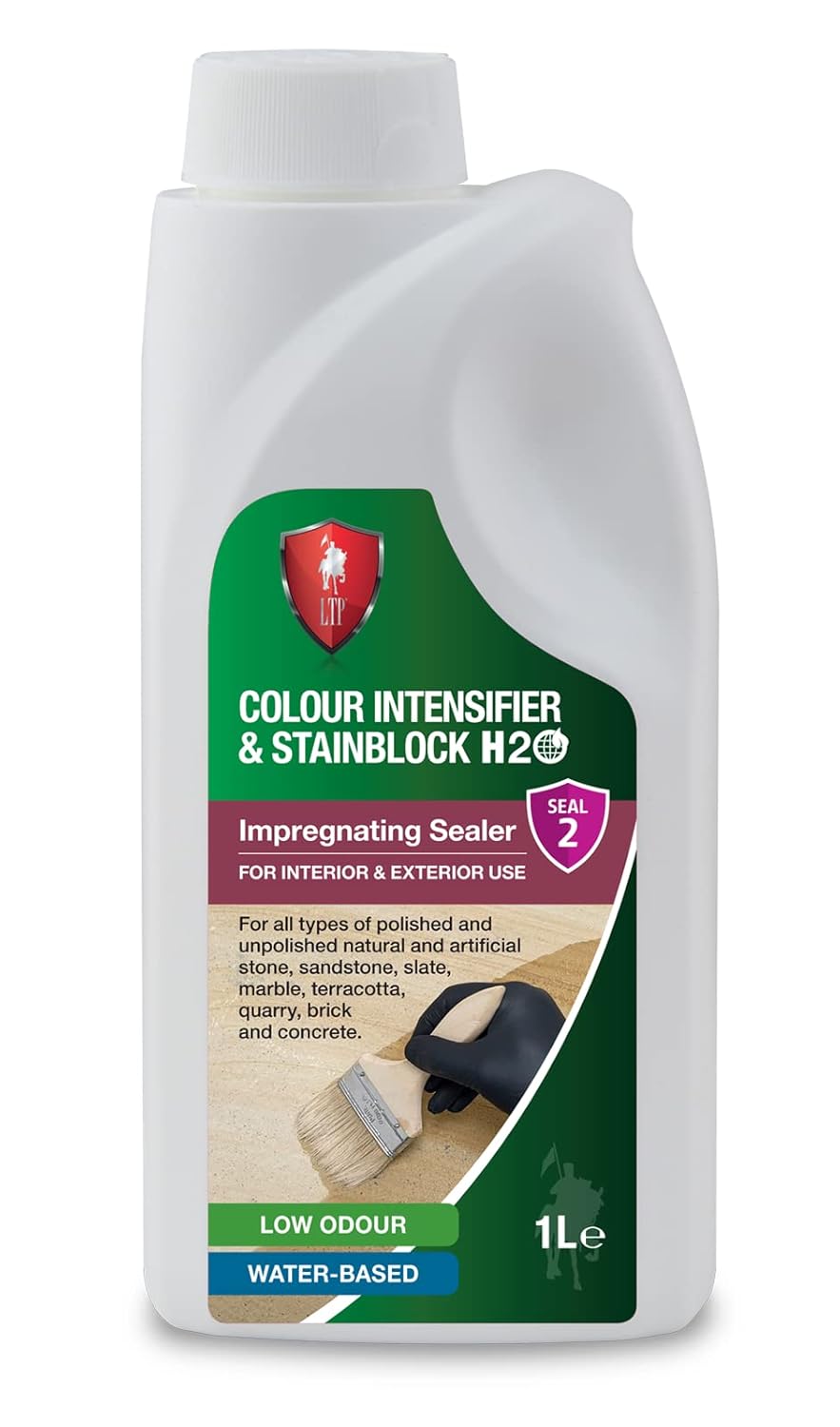
LTP Colour Intensifier & Stainblock H20
|
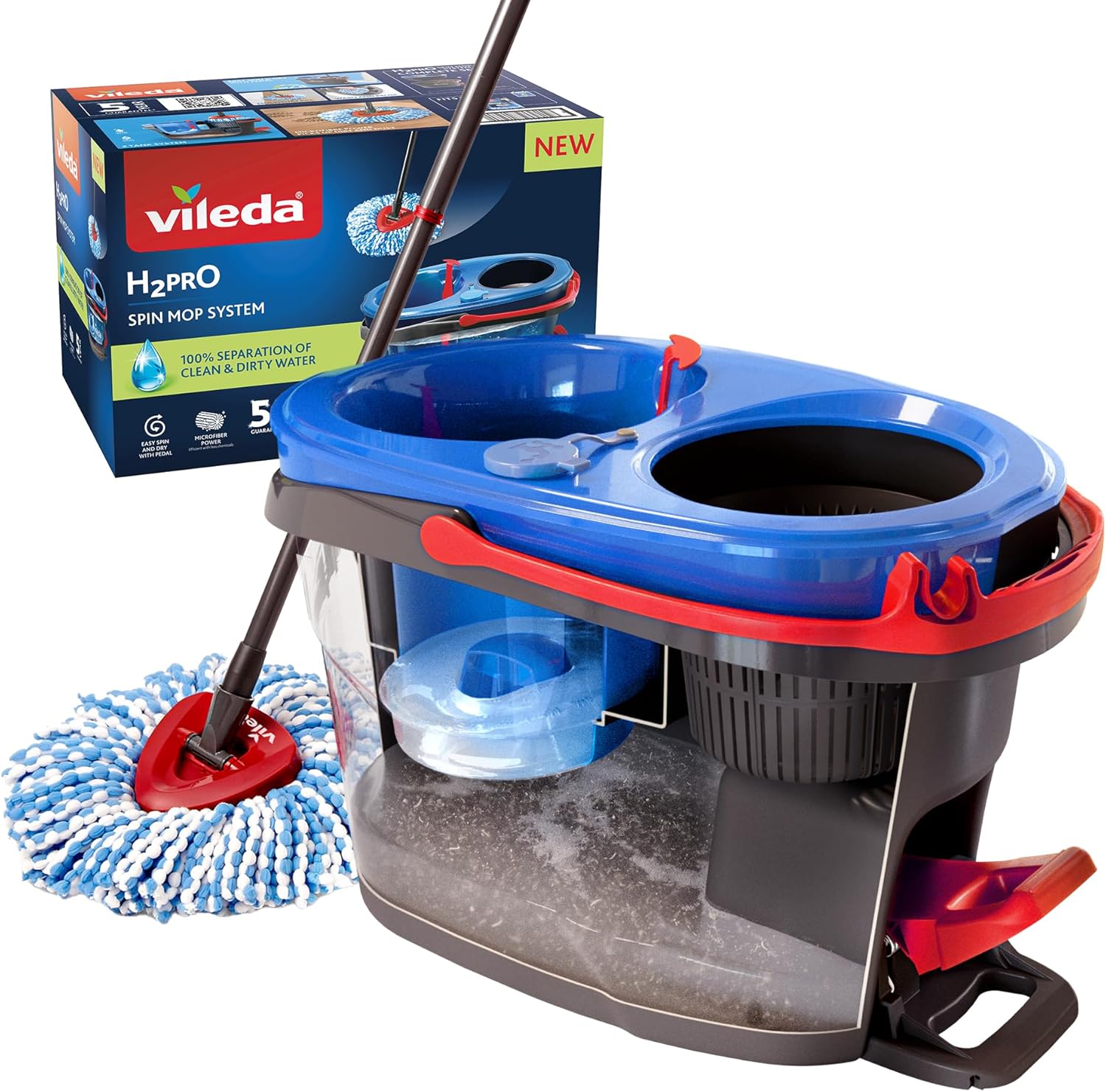
Vileda H2PrO Spin Mop System
|
Over time, these exquisite tiles often lose their visual appeal due to surface wear, chemical exposure, and environmental factors. The task of restoring their original vibrancy is a specialized endeavor that demands a thorough understanding of the materials in use, historically accurate techniques, and the application of high-quality products tailored for the job. This expertise not only aids in the restoration process but also ensures that the tiles maintain their aesthetic and functional qualities for years to come, celebrating the unique artistry of the Victorian era.
Uncovering the Reasons Behind Fading and Dulling of Victorian Mosaic Tiles

Example of Victorian Clay Tile Floor dulled through surface wear and damage.
While the pigments are integral to the tile’s character, several factors contribute to their fading and dulling over time:
- Accumulated dirt and grime: Continuous foot traffic results in the deposit of fine particles and oils that penetrate porous surfaces, scattering light and significantly muting colors. Regular cleaning is essential to mitigate this issue and maintain tile appearance.
- Wax and polish buildup: Layers of wax or sealants that lack breathability can trap moisture, resulting in a cloudy or yellowed appearance that detracts from the vibrancy of the tiles. Recognizing the importance of breathable products is crucial for effective maintenance.
- Moisture-driven issues: Many Victorian tiles were installed over subfloors without damp-proof membranes, leading to rising damp that transports soluble salts. These salts crystallize on the tile surface as efflorescence, obscuring the original tones and colors. Addressing moisture issues is critical during restoration.
- Physical abrasion: Small surface scratches accumulated from years of wear disrupt smooth light reflection, ultimately diminishing the visual richness of the tiles. Regular maintenance can help minimize such damage and preserve the tiles’ beauty.
Successful restoration must comprehensively address each of these contributing factors without compromising the historic integrity of the tiles, ensuring the renewal of their original beauty and preserving the stories conveyed through their intricate designs.
The Importance of Breathability in Restoration for Tiles Lacking Damp-Proof Membrane
Given that numerous Victorian tiled floors are situated on older subfloors that lack a damp-proof membrane (DPM), it is imperative that their natural clay structure remains permeable to facilitate the evaporation of moisture from the subfloor. Non-breathable wax coatings or film-forming sealers can obstruct this crucial evaporation pathway, leading to moisture accumulation beneath the surface. This, in turn, traps salts and humidity, which can cause efflorescence, surface mineral degradation, and the unwelcome phenomenon known as wax blooming—a whitish film or haze on the tile surface. Therefore, restoration strategies must prioritize the use of breathable impregnating sealers that protect the tiles while allowing moisture vapour to move freely, ultimately preventing long-term damage and preserving their historical value.
In-Depth Analysis of Pigments and Composition in Victorian Tiles
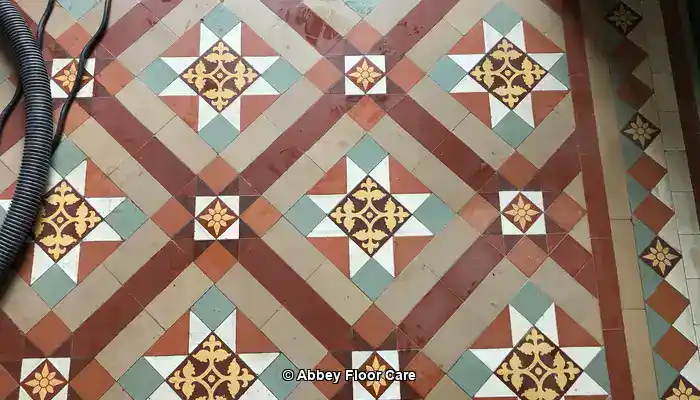
Exploring the Role of Mineral Oxide Pigments in Victorian Tiles
Victorian mosaic and encaustic tiles derive their unique earthy hues from mineral oxide pigments embedded deeply within the clay. These pigments not only enhance durability but also contribute to the richness of color. The primary pigments include:
- Iron oxide: generates warm terracotta reds, rust browns, and soft ochres, adding warmth to the tiles. Understanding their role is crucial for effective restoration.
- Manganese: provides rich browns and deep blacks, enhancing contrast and depth. Knowledge of these pigments is essential for accurate color matching during repairs.
- Cobalt: imparts various shades of blue, enriching the aesthetic variety. This diversity adds character to the overall design.
- Chromium: produces natural green tones, contributing to the palette of colors. The presence of these pigments highlights the artistry of the era.
Understanding the Firing and Fusion Process of Victorian Tiles
During production, tiles are fired at temperatures around 1100°C, a process that vitrifies the clay and fuses the pigments deeply into the tile body. This ensures the color permeates throughout the tile, rather than merely resting on the surface, resulting in enduring vibrancy resistant to fading. This firing technique reinforces durability and exemplifies the craftsmanship involved in creating these historical pieces.
Recognizing the Characteristics of the Porous Unglazed Finish of Victorian Tiles
Victorian tiles typically exhibit a porous, unglazed matte finish that offers a natural look. However, this porosity renders the tiles absorbent and sensitive to surface contamination and moisture, necessitating meticulous cleaning and maintenance to uphold their integrity and aesthetic charm. A comprehensive understanding of these characteristics is essential for effective care and restoration of these historic tiles.
Understanding Variability in Colour Durability Among Different Tile Types
Natural earth pigments, particularly in red and yellow tiles, generally contain fewer mineral additives compared to darker hues such as black, which are formulated with manganese. This variance in composition implies that red and yellow tiles are less durable and more susceptible to surface dishing under heavy traffic. Over time, this wear manifests as shallow depressions where foot traffic is concentrated, leading to uneven color intensity and a diminished surface flatness that detracts from their overall appeal. Awareness of these differences is essential in developing targeted restoration strategies.
Key Considerations for Successful Victorian Tile Restoration
A thorough understanding of pigment composition and wear patterns is vital in creating a successful restoration plan. Softer-toned tiles require gentler cleaning methods and specialized impregnating sealers that respect their unique physical properties while enhancing color. Conversely, darker, more robust tiles can endure more intensive cleaning yet still necessitate breathable, color-enhancing protection to maintain vibrancy over time. This tailored approach is crucial for preserving the historical and aesthetic qualities of the tiles.
Advanced Cleaning Strategies for Revitalizing Victorian Mosaic Tiles
Effective cleaning is paramount in restoring Victorian encaustic and mosaic tiles to their original vibrancy. The cleaning approach must go beyond basic pH-neutral detergents commonly recommended. Professionals in the field utilize carefully formulated alkaline cleaners and mechanical methods to dislodge heavy soiling and old residues without compromising the historic fabric of the tiles. Understanding proper cleaning techniques is critical for achieving the desired restoration results.
The Importance of Removing Debris Before Cleaning
The cleaning process initiates with the removal of all loose dirt and grit using soft brushes or vacuuming with brush attachments. This preliminary step is essential in preventing scratches on the delicate tile surfaces during subsequent cleaning phases, thereby ensuring that the restoration process is as effective as possible. This meticulous attention to detail is crucial for preserving the tiles’ integrity throughout the cleaning process.
Employing Alkaline Cleaners for Thorough Soil Removal
Unlike pH-neutral cleaners, which often lack the chemical strength necessary to tackle ingrained fatty acids and organic soils, alkaline cleaners are vital for effectively breaking down household oils, grease, and sticky residues commonly found on tile surfaces and within grout lines. These alkaline solutions dissolve the binding agents of dirt, sugars, and fats, facilitating their efficient removal while remaining compatible with the mineral composition of Victorian tiles. Utilizing high-quality alkaline products ensures a thorough clean while safeguarding the tiles.
Professional-grade alkaline products, such as PS87 PRO or custom formulations from heritage cleaning specialists, are typically used in diluted forms. This careful approach guarantees deep cleaning without being overly aggressive on the clay body. It is essential to note that even when using alkaline cleaners, caution is crucial, and spot testing is highly recommended to avoid any unintended damage, thus protecting the tiles’ historical significance.
Mechanical Agitation with Appropriate Pads for Enhanced Cleaning Efficiency
Mechanical action significantly boosts cleaning efficiency. Low-speed rotary scrubbers fitted with red or, in some instances, green non-abrasive pads are commonly employed to agitate soils from small pits, tile surfaces, and grout lines. These pads clean thoroughly while preserving the integrity of tile edges and delicate surface details, ensuring that the restoration maintains the original character of the tiles. This method strikes a balance between effective cleaning and preservation of historical value.
Targeted Removal of Waxes and Exotic Sealants
The buildup of old waxes and sealants is often a byproduct of years of use, particularly from DIY attempts using inappropriate products. Water-based cleaners—whether alkaline or mildly acidic—are preferred for removing these residues, as they do so without damaging the tile’s mineral structure. However, stubborn ‘exotic’ or solvent-resistant coatings may necessitate targeted solvent-based removers such as Lithofin Wax-Off or LTP Solvex. These solvents effectively soften and emulsify waxes and old sealants but must be handled carefully by trained professionals to prevent damage. Employing the right approach is essential to protect the tiles’ integrity throughout the cleaning process.
Thorough Rinsing and Drying After Cleaning
Following chemical cleaning, thorough rinsing is essential to eliminate all cleaning residues. Multiple rinses with clean water, combined with wet vacuum extraction, ensure that no traces of detergent or solvent remain that could interfere with subsequent restoration coatings. Drying time can vary significantly based on environmental conditions, such as humidity, surface type, and moisture content. Restoration experts consistently utilize moisture meters to confirm that the tiles are fully dry prior to applying any impregnating sealers or protective treatments. This approach is crucial in preventing moisture entrapment, which could lead to efflorescence, staining, or damage underneath sealed layers, ultimately protecting the historical fabric of the tiles.
The Advantages of Comprehensive Cleaning as Preparation for Restoration
A thorough cleaning process uncovers the true condition of the tiles by eliminating visual obstructions. This exposure allows for the identification of areas that may require repair and provides a clean, receptive surface for color-enhancing impregnators or other restorative products. This meticulous preparation is fundamental to the success and longevity of Victorian mosaic tile restoration, ensuring that the tiles can be appreciated for generations, preserving their rich history and craftsmanship.
Revitalizing Colour with High-Quality Impregnating Sealers
Restorers utilize premium impregnating color-enhancing sealers from reputable brands such as LTP and Lithofin, known for their advanced, heritage-approved formulations. Unlike superficial coatings, these sealers:
- Deeply penetrate tile pores to enhance color by altering light refraction, revitalizing the tile’s overall appearance. This depth of penetration is crucial for long-lasting effectiveness.
- Maintain vapour permeability, which is essential for moisture release and particularly critical in older floors lacking DPM layers. This feature supports the tiles’ health over time.
- Offer durable protection against stains and foot traffic while preserving the natural texture and gloss of the tiles. This protective layer ensures longevity and aesthetic appeal.
- They are applied in multiple light coats, with each layer allowed to penetrate before the next is added to ensure complete uniformity. This meticulous application process significantly enhances the overall appearance.
These sealers effectively combat fading by restoring vibrancy while maintaining the breathable nature of historic floors, ultimately enhancing the overall aesthetic of the tiles and underscoring their historical importance.
Meticulous Repair of Damaged Tiles and Colour Tinting Techniques
Tiles with chips, cracks, or missing sections require careful repair using tinted epoxy or lime-based mortars, colour-matched with natural mineral oxides. Restoration experts often source matching replacement tiles from salvage archives to ensure pattern continuity. Colour tinting involves the selective application of earth-pigment-infused wax or resin mixtures to blend worn or missing pattern areas sensitively, all while respecting the tile’s breathability and reversibility to ensure that any restoration can be undone if necessary. This meticulous approach guarantees that repairs harmonize seamlessly with the original design.
Best Practices for Effective Colour Tinting
- Utilize small, controlled applications to avoid overt colouring that could disrupt the tile’s original appearance. Precision is key in maintaining authenticity.
- Conduct patch testing on inconspicuous areas before full application to ensure compatibility and effectiveness, safeguarding the tiles against potential damage.
- Ensure compatibility with the impregnating sealers applied to the entire surface, protecting the integrity of the restoration. This careful consideration is crucial for long-term success.
Long-Term Maintenance Strategies for Preserving Restored Victorian Mosaic Floors
Maintaining the restored colour and condition of Victorian mosaic tiles necessitates ongoing care and attention:
- Regular cleaning with pH-neutral, non-abrasive detergents specifically designed for historic tiles is essential. This practice helps keep the tiles in excellent condition.
- Implement preventive measures, such as placing entrance mats to minimize dirt ingress, thus protecting the tiles from unnecessary wear. This simple strategy can significantly extend the life of the tiles.
- Promptly address liquid spills, particularly acidic substances like vinegar or wine, to prevent surface etching and discoloration. Quick action is crucial for tile preservation.
- Regularly reapply breathable impregnating sealers every 3–5 years or as needed to ensure continued protection. This proactive maintenance is vital for sustaining tile vibrancy.
- Monitor floors for signs of efflorescence or moisture ingress, which may indicate underlying damp issues needing attention. Staying vigilant is essential for maintaining tile integrity.
Avoiding Common Mistakes in Tile Restoration Projects
- Avoid wax treatments that can obstruct breathability, trigger efflorescence, or lead to wax blooming. Understanding product compatibility is crucial for successful outcomes.
- Do not use acrylic or polyurethane sealants that can trap moisture and cause degradation over time. Choosing the right sealant is vital for protecting historical value.
- Limit the use of harsh chemical cleaners, as they can erode the clay and pigments, resulting in irreversible damage. Gentle cleaning solutions are key for preservation.
- Never repaint tiles; paint films alter their visual and physical properties and are not reversible, ultimately compromising the tile’s integrity. Authenticity should always be preserved.
- Recognize and address issues in older subfloors before sealing to ensure any underlying problems are properly rectified. This proactive approach is fundamental for successful restoration.
Showcasing Successful Victorian Tile Restoration Case Studies
Examples of successful restoration highlight the effective application of these principles:
Transformative Restoration of a Victorian Hallway in Sheffield
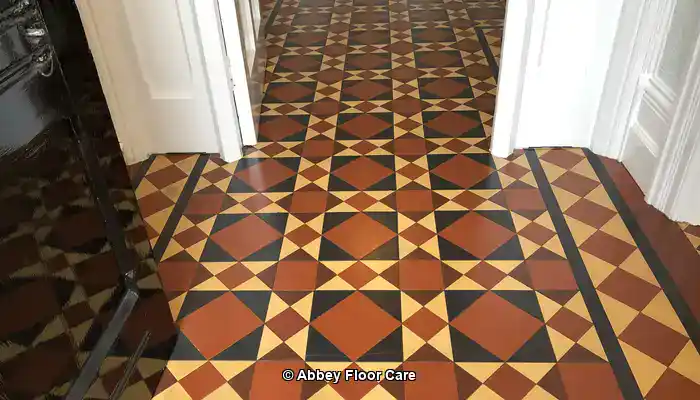
Our meticulous cleaning process successfully eliminated years of wax and grime, followed by the application of a Lantania Avo colour-enhancing impregnating sealer, which visibly deepened the tile colours. This was subsequently followed by applying an acrylic topical sealer to provide surface protection on floors installed over a damp-proof membrane, ensuring their longevity and aesthetic appeal. This project exemplifies the successful integration of restoration techniques and historical preservation.
Expert Restoration of a Civic Mosaic Floor in Chesterfield
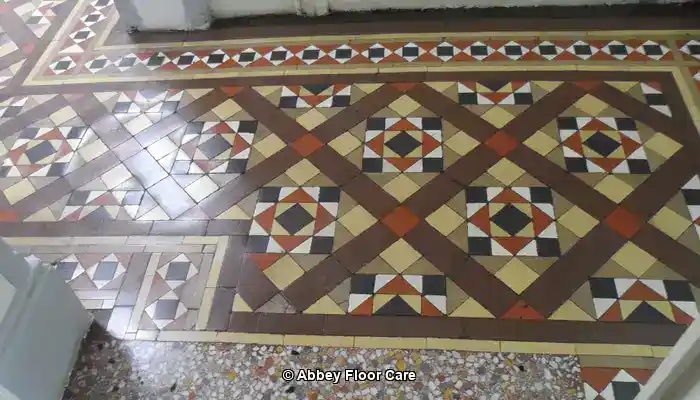
After cleaning and removing old topical sealers, the floor was sealed with an LTP Colour Enhancing Impregnating sealer. The surface was further protected with a wax, applied meticulously to seamlessly integrate the clay tiles into the historic fabric of the building, preserving its character while enhancing its visual appeal. This careful approach underscores the importance of sensitivity to the original design.
The Essential Role of Professional Restoration in Heritage Preservation
Restoring the colour and pigment of Victorian mosaic tiles represents a multifaceted task that harmonizes material science, craftsmanship, and sensitivity to heritage values. By utilizing premium impregnating colour-enhancing sealers from industry leaders such as Dry Treat, Lantania, and Lithofin, one can ensure long-term breathability, protection, and vibrancy of colour in these historic tiles. Through skilled cleaning, careful repair, and dedicated maintenance, we can uphold authenticity while rejuvenating these significant floors for future generations to appreciate and enjoy, thus ensuring that the rich history and artistry of these tiles remains vibrant.
Your Frequently Asked Questions on Victorian Tile Restoration Answered
What are Victorian mosaic tiles and why are they significant?
Victorian mosaic tiles are decorative tiles that became popular in the 19th century, renowned for their vibrant hues and intricate patterns. Frequently installed in public buildings and residences, they epitomize the craftsmanship of the era’s architectural style, symbolizing the artistry of their time.
How can I effectively restore faded Victorian mosaic tiles?
Restoring faded Victorian mosaic tiles requires a comprehensive process involving cleaning, repairing damages, applying new pigments to match the original colours, and sealing the tiles to protect them from future wear and fading. This multi-step approach is essential for a successful restoration.
What materials are critical for tile restoration projects?
Essential materials for tile restoration include specialized cleaning solutions, pigments, adhesives, grout, and protective sealants, all chosen for their compatibility with the original tiles to ensure an effective restoration. Selecting the right materials is crucial for achieving optimal results.
How long does the Victorian tile restoration process typically take?
The timeline for tile restoration can vary widely based on the size and condition of the area being restored, typically ranging from a few days for smaller projects to several weeks for larger restorations requiring extensive work. Understanding this timeline is important for proper planning and expectations.
Can I undertake the restoration of Victorian tiles myself?
Yes, smaller restoration projects can often be approached as a DIY endeavor if you possess the necessary skills and tools. However, more complex repairs generally require professional expertise to ensure quality results and to avoid damaging the tiles, emphasizing the importance of experience.
What is the cost associated with restoring Victorian mosaic tiles?
Costs for restoration can vary significantly based on project size and condition, with estimates ranging from a few hundred to several thousand pounds for comprehensive restorations, depending on the extent of work needed. Understanding potential costs is vital for budgeting effectively.
How do I select the right restoration expert for my project?
When searching for restoration professionals, prioritize those with experience in historical projects, positive reviews, and a commitment to using authentic materials and techniques that align with heritage preservation values. This diligence ensures quality restoration work.
What challenges do restorers frequently encounter during the process?
Restorers often face challenges such as matching original colours, repairing damaged tiles, and ensuring the longevity of the restoration while maintaining the tiles’ historical integrity. Recognizing these challenges prepares restorers for effective solutions.
How can I maintain restored tiles to ensure their longevity?
Regular cleaning with pH-neutral products, avoiding harsh chemicals, resealing periodically, and promptly addressing any damage are key strategies for maintaining the quality and appearance of restored tiles over time. Consistent care is crucial for preservation.
What innovations are currently present in tile restoration practices?
Recent innovations in tile restoration encompass advanced cleaning solutions, new types of sealants, and digital technology for precise colour matching and pattern replication in restoration projects, enhancing both efficiency and effectiveness while showcasing the evolution of restoration techniques.
The Article Restoring Colour and Pigment to Faded Victorian Mosaic Tiles first found on https://www.abbeyfloorcare.co.uk
The Article Restoring Colour to Faded Victorian Mosaic Tiles appeared first on https://fabritec.org
The Article Restoring Faded Victorian Mosaic Tiles to Their Original Color Was Found On https://limitsofstrategy.com





No responses yet